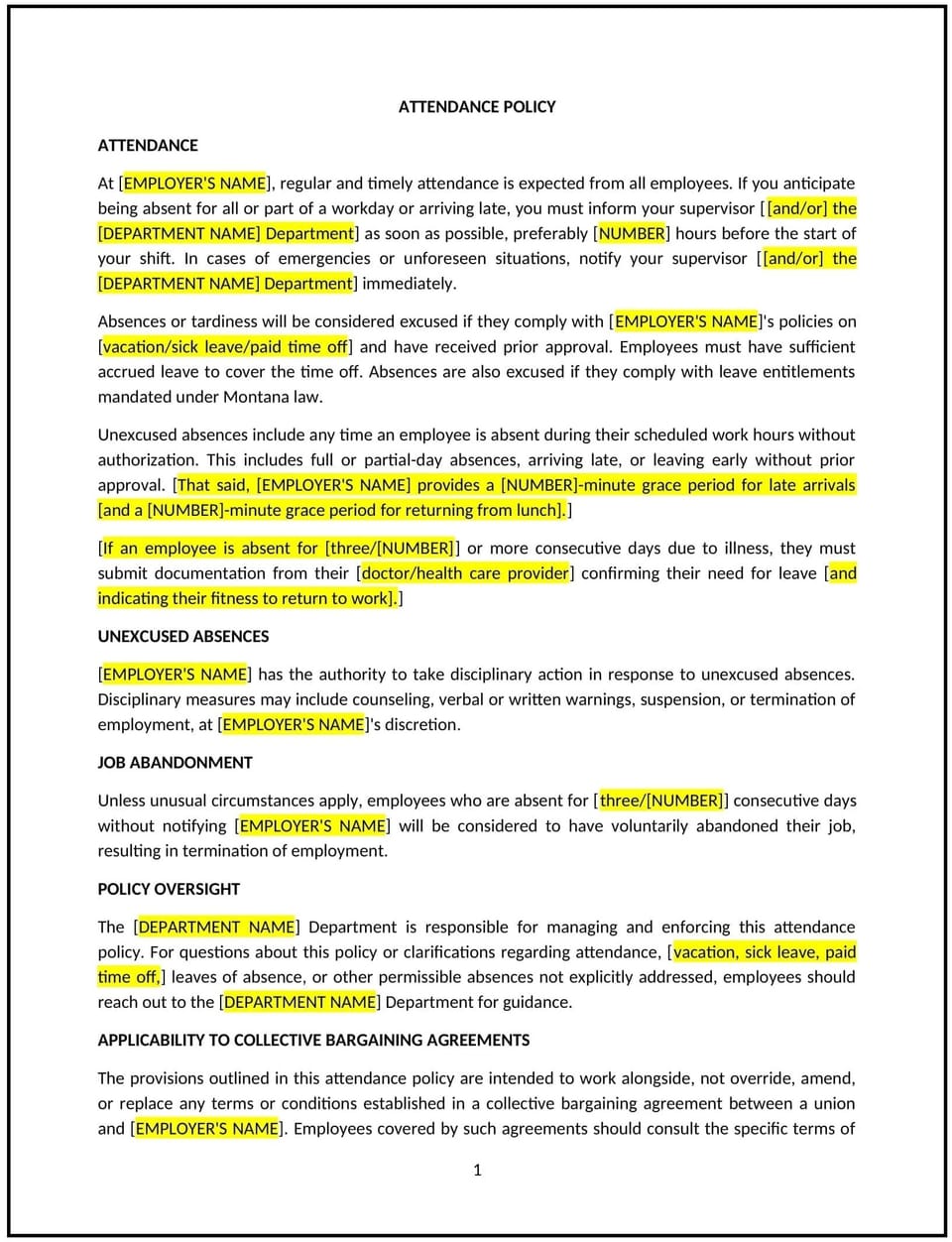Attendance policy (Montana): Free template

Attendance policy (Montana)
An attendance policy helps Montana businesses establish clear expectations for employee punctuality, absences, and time management. This policy outlines the procedures for reporting absences, handling tardiness, and addressing excessive absenteeism. It also provides guidelines for managing leave requests while maintaining business operations.
By implementing this policy, businesses can promote workplace accountability, minimize disruptions, and ensure employees understand their attendance responsibilities.
How to use this attendance policy (Montana)
- Define attendance expectations: Businesses should establish clear guidelines for work hours, shift schedules, and remote work attendance. Employees should understand the importance of consistent attendance in maintaining productivity.
- Set absence notification procedures: Businesses should require employees to report absences within a specified timeframe and through designated communication channels, such as a direct call to a supervisor or an online attendance system.
- Address tardiness and early departures: Businesses should define what constitutes tardiness and early departures, along with any grace periods. The policy should outline the steps for addressing recurring lateness.
- Outline leave request protocols: Employees should follow a structured process for requesting planned time off, including how far in advance requests should be submitted and approved.
- Define consequences for excessive absenteeism: Businesses should specify disciplinary measures for repeated unexcused absences, such as verbal warnings, written notices, or further corrective action.
- Include accommodations for emergencies: Businesses should acknowledge that unforeseen circumstances may arise and provide guidelines on how employees should communicate emergency absences.
- Review and update regularly: Businesses should periodically assess the policy to align with operational needs, employee feedback, and Montana labor laws.
Benefits of using this attendance policy (Montana)
This policy provides several key benefits for Montana businesses:
- Promotes workplace accountability: Clear expectations help employees take responsibility for their attendance.
- Reduces productivity disruptions: Businesses can minimize workflow interruptions by maintaining consistent staffing levels.
- Establishes a fair and structured approach: Employees understand how absences and tardiness are handled, reducing uncertainty.
- Enhances communication: A defined process for reporting absences improves coordination between employees and management.
- Supports workforce planning: Businesses can plan schedules effectively when attendance policies are consistently applied.
- Encourages employee responsibility: Employees are more likely to follow attendance expectations when policies are communicated and enforced fairly.
Tips for using this attendance policy (Montana)
- Communicate attendance expectations clearly: Businesses should provide employees with written guidelines and training on attendance requirements.
- Establish a consistent reporting process: Employees should know the exact steps for notifying supervisors of absences or tardiness.
- Apply disciplinary measures consistently: Businesses should enforce attendance policies fairly across all employees.
- Encourage proactive communication: Employees should be encouraged to communicate planned absences as early as possible to reduce scheduling disruptions.
- Document attendance issues: Businesses should maintain records of attendance infractions and disciplinary actions to ensure transparency.
- Provide flexibility when possible: Businesses should consider reasonable accommodations for emergencies or special circumstances while maintaining operational needs.
Q: Why should Montana businesses implement an attendance policy?
A: Businesses should implement an attendance policy to set clear expectations for employee attendance, improve productivity, and ensure workplace efficiency. A structured policy helps reduce absenteeism and maintain operational stability.
Q: What should businesses include in an attendance policy?
A: Businesses should outline attendance expectations, reporting procedures, disciplinary actions for repeated absences, leave request protocols, and emergency absence guidelines.
Q: How should businesses handle repeated tardiness?
A: Businesses should document instances of tardiness, address the issue with employees, and apply corrective measures such as verbal warnings, written notices, or other disciplinary actions.
Q: What reporting procedures should businesses establish for absences?
A: Businesses should require employees to notify their supervisor or HR within a specific timeframe and through approved communication methods, such as phone calls, emails, or attendance tracking systems.
Q: Can businesses provide flexibility for employees with personal emergencies?
A: Businesses should have procedures for handling emergency absences, ensuring employees communicate their situations promptly while maintaining fairness in policy application.
Q: How should businesses track employee attendance?
A: Businesses should use attendance tracking systems, timesheets, or automated software to monitor employee absences, tardiness, and time-off requests.
Q: What disciplinary actions should businesses apply for excessive absenteeism?
A: Businesses should follow a progressive discipline process, starting with verbal warnings, followed by written notices, and escalating to suspension or termination if necessary.
Q: Should businesses require documentation for absences?
A: Businesses should determine when medical notes or other documentation are required for extended absences or repeated unexcused time off.
Q: How often should businesses review their attendance policy?
A: Businesses should review the policy at least annually or whenever operational needs change to ensure it remains effective and practical.
Q: Can attendance policies differ for remote employees?
A: Businesses should define attendance expectations for remote employees, including availability hours, communication requirements, and reporting procedures for absences.
This article contains general legal information and does not contain legal advice. Cobrief is not a law firm or a substitute for an attorney or law firm. The law is complex and changes often. For legal advice, please ask a lawyer.


